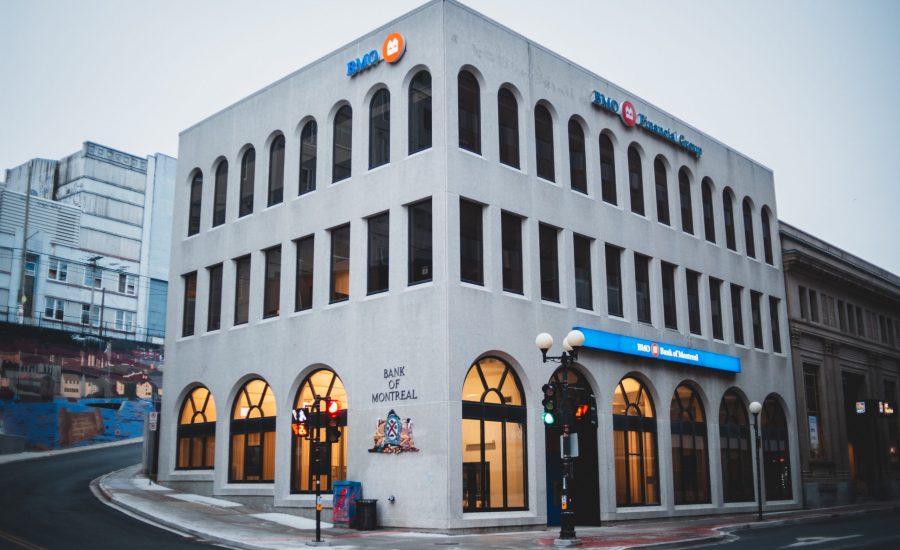
Photo by Erik Mclean on Unsplash
Each week, Cut the Crap Investing founder Dale Roberts shares financial headlines and offers context for Canadian investors.
Canadian banks attract investors—and criticism
The Canadian banks have started reporting first quarter earnings, and they’re off to a roaring start.
At the same time, the banks are attracting considerable criticism for increasing fees during a pandemic, and when they themselves are enjoying such financial success.
And as I have suggested on many occasions, Canadian banks always find ways to make money. They have many oars in the water, including increasing fees for everyday banking. I would suggest Canadians search for the lowest fee option at their bank. If lower-fee options are not available, then you might consider switching to a low-fee or no-fee bank account.
For our cash, my wife and I are using EQ Bank. I like the service a lot. I have also reviewed EQ Bank on my site.
But, back to the markets’ POV. As Larry Bates, a MoneySense contributor and author of the popular book Beat the Bank smartly suggests, we are better to invest in the banks rather than banking or investing with them.
As we move out of the pandemic, Canadian banks are now firing on all cylinders, mostly beating profit and revenue-growth estimates.
BMO kicked things off in style the morning of Wednesday, May 26: Profits rose to $1.3 billion from $689 million a year earlier.
From that BNN Bloomberg Canada post, in reference to how the banks handled 2020…
“Back then, BMO and its peers set aside billions of dollars for loans that they feared could go bad as a result of COVID-19’s impact on the economy.
“But that tidal wave of sour loans hasn’t materialized. Indeed, BMO said on Wednesday it booked just $60 million in total provisions during the latest quarter, compared to $1.12 billion a year earlier and $156 million in the fiscal first quarter. Further underscoring the magnitude of the improved credit landscape: BMO reversed provisions that had previously been booked in three of its four major divisions.”
That is the general trend and positive force running through the Canadian banks’ reports. While the overall economic backdrop and prospects are improving thanks to the likelihood that the pandemic is now under control, the banks are now able to set aside less money for bad loans (provisions for credit losses). That can boost the profits for the quarter.
And boost it has.
CIBC delivered profits that tripled from the pandemic lows of 2020.
TD is flush with cash, as profit surged 144%.
RBC’s profit in the three-month period that ended April 30, 2021, surged 171% to $4 billion, compared to $1.5 billion a year earlier.
We’ll see how much of this optimism was already priced into Canadian bank stocks; consider that the banking sector doubled up on the returns of the TSX composite over the last year.
That said, the banks continue to add on to recent gains. The index, using the BMO Equal Weight Banks ETF, is up more than 2% over the last week.
Many suggest there is still very solid value in the Canadian banks. And they may soon get permission from regulators to get back to their habit of increasing dividends.
In a post from February, we wondered if the banks might soon be allowed to pay a special dividend. A source told me the banks are eager to make up for the total of missed dividend increases from the pandemic.
Fingers crossed. I’ll be listening for any regulatory whispers.
Bitcoin energy council to the rescue?
We touched on the troubles of bitcoin in last week’s last week’s column.
From that post…
“And the correction has accelerated. From the highs in mid-April, when bitcoin eclipsed $64,000 U.S., it has fallen to as low as $31,478 on May 19. On Thursday, May 20, bitcoin had recovered slightly, to nearly $42,000.”
The price of bitcoin has hung in there over the last week. On Thursday, May 27, it was trading near $40,000 U.S. Seems it has found some footing, for now.
One of the main hurdles for bitcoin is the energy usage by bitcoin miners and the overall energy demands for bitcoin transactions. Bitcoin needs to tackle the energy problem.
And of course the bitcoin community is going to fight back. It appears that there will need to be a greener path forward for bitcoin mining and transactions. On Seeking Alpha, this post on bitcoin energy use offered…
“The miners agreed to form the Bitcoin Mining Council ‘to promote energy usage transparency & accelerate sustainability initiatives worldwide,’ Saylor said.”
Michael Saylor is the co-founder of MicroStrategy. In this post and video on Coindesk, Saylor proclaimed…
“Mining Council Will ‘Defend’ Bitcoin Against ‘Uninformed’ and ‘Hostile’ Energy Critics”
From Bitcoin Magazine, here’s a post that frames bitcoin energy usage. And, as with most stats, it’s all about how you frame it…
“Over 1 billion people have no access to the electrical grid but still have access to energy via physical fuels. Just like they don’t need the grid to survive, neither do bitcoin miners, many of whom are now using flared methane in remote oil fields to mine bitcoin. Of the 160,000 TWh of energy generated worldwide each year, 50,000 TWh is lost to inefficiency, and only 25,000 TWh is generated by electrical grids bitcoin consumes around 120 TWh, a mere 0.25% of the energy wasted each year, or 0.5% of the world’s grid electricity, representing less than 0.1% of human energy production. Pick your poison with the framing.”
Globally, leaving our computers on overnight represents 0.2% of energy consumption. There ya go, more framing.
The bitcoin community is not standing still. According to Greg Foss of Validus Power Corp, bitcoin miners are shifting away from more carbon-intensive regions, like Asia, and looking to move west, including to Canada.
Validus offers more energy-efficient solutions for bitcoin miners, and Foss says inquiries for their solutions have been overwhelming in recent weeks. The 2 GW (gigawatts) of power they have available for miners is already spoken for, and then some. Validus has plans not only to create a carbon neutral setting by way of the purchase of carbon offsets, but to use carbon-capture technology as well.
Foss notes there are many energy-efficient solutions in play around the globe. Bitcoin is not going away any time soon, and the community can set an example as an asset that addresses a problem and responds with real solutions.
From my point of view, this is a major test. Bitcoin is facing some big challenges, but the right answer could strengthen its position and rate of adoption.
And also to be considered is the long-term comparison of bitcoin energy usage versus the traditional banking and financial transacting that bitcoin hopes to replace.
Stay tuned for more framing, and more bitcoin battles.
Gold is not down for the count, yet
For gold bugs, there were fears that bitcoin (the new gold) is replacing or muscling out gold as the inflation hedge of choice. Investors also use gold as a long-term store of value and a form of disaster insurance; it’s often known as a safe-haven asset.
But the shine is back for gold as bitcoin struggles. Goldman Sachs says gold will go up 20% by year end…
“Goldman Sachs expects gold to jump almost 20% from its already record level to reach $2,300 in the next 12 months on rising concerns over the US dollar’s global standing as a reserve currency.
“Analysts at the bank continue to think that gold has plenty of room to run against a backdrop of rising geopolitical tensions, elevated political and social uncertainty in the US, and a swelling COVID-19 second wave.
“‘With more downside expected in US real interest rates, we are once again reiterating our long gold recommendation from March and are raising our 12-month gold and silver price forecasts to $2300/toz and $30/toz respectively from $2000/toz and $22/toz,’ analysts from the bank said.”
In this tweet from Liz Sonders of Goldman Sachs, we can see that Gold has taken a leadership position in the commodities space:
Real interest rates are the solid predictor for gold price moves. Gold has an inverse relationship to real interest rates (the amount that you make with savings when you factor in inflation). You’ll find that chart and some greater insights on the role of gold in the portfolio in this post from Banker on Wheels.
For a deeper dive on gold in the portfolio, you might also enjoy this post on the permanent portfolio. While most would not be inclined to hold a 25% gold position, the portfolio concept clearly demonstrates the benefits of holding assets for each economic condition.
I’m happy to hold gold, along with that modern gold known as bitcoin.
Who knows which asset will win the long-term battle; perhaps there’s room for both of ’em?
The TSX is at a record high. What to do?
On Thursday, May 27, Canadian stocks (TSX Composite) hit a new record high. And, on top of that, the Canadian dollar has been one of the best-performing currencies over the last several months: It’s up almost 12% vs. the U.S. dollar over the last year.
That strong loonie gives Canadian investors even more buying power for any rebalancing they need to do.
Canadians are known to have an exaggerated home bias. That is, we invest too heavily in Canadian stocks compared to U.S. and International stocks considering that Canada is only some 3% of the global economy. It’s not uncommon to hear of Canadian investors holding 30%, 40%, even 50% or more in Canadian stocks. We might ignore other asset classes as well.
And, full disclosure: I, too, suffer from Canadian home bias. I like our stocks’ big, juicy dividends for a portion of my personal portfolio. Guilty as charged.
Right now, we Canucks are having our day in the sun, and we might make some diversification hay while that sun shines. I like to call it “fixing portfolio holes.”
Of course, what’s required to fix any portfolio weaknesses is unique to each investor. We all have different strengths and different portfolio holes, or portfolio potholes. On the top line, we want to ensure that we are investing within our own risk tolerance level. And then we want to ensure that we build in geographic and asset diversification.
I asked Arthur Salzer, of Northland Wealth Management, where an investor might find opportunities. Northland is an award-winning family office. They manage money and wealth for more affluent individuals and families in Canada and around the globe. And Salzer says families are overweight Canadian stocks in the 20% range. (If you need a checkup, you might touch base with a fee-for-service advisor.)
Canadian stocks are on a good run, thanks largely to the financial, and resource and mining sectors. They’ve offered more value compared to the U.S. markets that have outperformed for more than a decade.
In search of greater value Salzer has been moving clients into more equal-weight U.S. stock funds, compared to the cap-weighted S&P 500.
Salzer says families are 7.5% to 10% Canadian real estate, and might consider currency hedging where possible, given the strong run for the Canadian dollar.
Yves Rebetez of Credo Consulting is not a fan of bonds these days, save for emerging market bonds. And on the portfolio front, he says: “I think the discussion for Canadians and holes goes back to sector overweights, gaps in exposures, greater breadth in value and small caps elsewhere, and other factors like momentum and quality.”
He would also add gold to the list of rebalancing opportunities. I am in agreement there on gold, adding commodities. Emerging market stocks might be a good consideration as well.
And I will not shy away from bonds. Investors might consider that long-short bond ladder. Longer bonds (treasuries) can manage stock market corrections, while shorter bond funds will not be as vulnerable to price decreases in a rising-rate environment. Those shorter bonds can also deliver increasing income over time, should that rising-rate environment materialize.
I hope the stock market gains continue. It’s not difficult to find a good home for a portion of those profits.
Dale Roberts is a proponent of low-fee investing who blogs at cutthecrapinvesting.com. Find him on Twitter @67Dodge.
Dale Roberts is a former investment advisor and proponent of low-fee investing. He created the Cut The Crap Investing blog in 2018. Find him on Twitter for market updates and commentary, every day.












Canadians having a home bias? Three words: “Canadian Eligible Dividends”. The government makes us buy Canadian stocks so we pay little tax on the dividends.